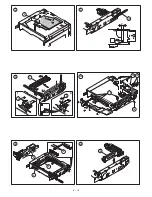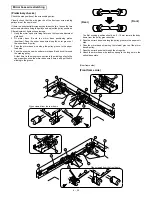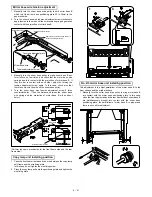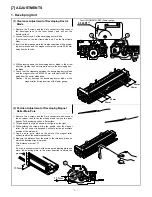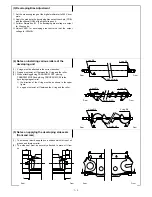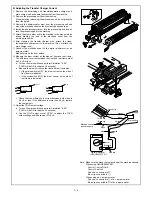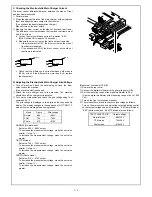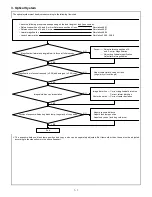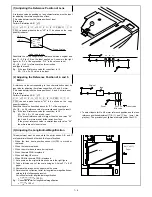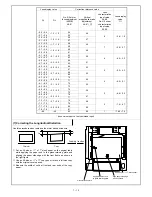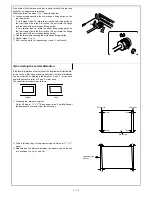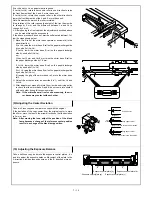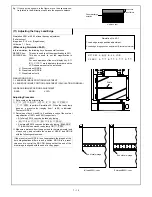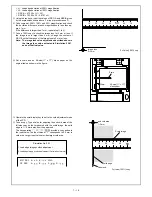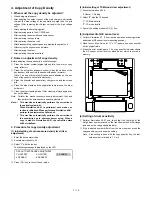
(5) Adjusting the Lateral Magnification
The lateral magnification should be adjusted in the following cases:
•
When the main PWB is replaced.
•
When the RAM in the main PWB is replaced.
•
When self diag U2 occurs.
•
When the mirror motor is replaced.
Change the mirror base scan speed to adjust the lateral magnifica-
tion ratio.
1
Set a scale on the original table as shown in the figure and
perform Simulation 48-02.
The machine starts the warm-up cycle and the ready lamp is lit.
At the same time a preset value (ranging from 15 to 35) is
indicated.
Now take a full-size copy of the scale and determine the correc-
tion factor for lateral magnification according to the following
expression:
Correction factor for lateral magnification = [(original size – copy
size)/original size] x 100 (%)
2
Use the correction factor to change the indicated value:
Value to be input = (preset value) + (correction factor for lateral
magnification(%)) x 10
•
Eg.1: 35 = 25 + 1 x 10
•
Eg.2: 15 = 25 + (–1 x 10)
When a new value is typed and the print switch is pressed, the
new value is stored in memory and the ready lamp goes off.
3
Clear Simulation 48-02.
Note: In Simulation 48-02 the correctable range of the
preset value is limited from15 to 35.
SIMULATION NO.48-
*
1. FRONT/REAR MAGNIFICATION RATIO ADJUSTMENT
2. PAPER TRANSPORT DIRECTION MAGNIFICATION RATIO ADJUSTMENT
PAPER TRANSPORT DIRECTION MAGNIFICATION RATIO ADJUSTMENT
(5 - 20 - 35)
(6) Inputting the Lens Travel Correction Value
(Simulation 26-08, 26-09)
<Inputting the lens characteristics>
The lens varies in focal length for each machine. The lens travel is
required to correspond to the focal length of the lens. If the lens
travels at a magnification would be constant among the machines
in spite of the focal length irregularity, the magnification could vary
depending on this irregularity.
To avoid this problem, we have prepared the table showing focal
length ranks of lens and correction data (see the next page) which
can be stored in memory at the time of Simulations described
below. In order to copy properly at a magnification, the lens travel
corresponding to its focal length is calculated on the basis of the
stored data.
<When lens is replaced>
1
Set correction data according to the "focal length ranks of lens
and correction data" table at following Simulation:
C
→
=
↵
→
0/
↵
→
=
↵
→
2
→
6
→
PSW
→
9
→
PSW to perform Simulation 26-09.
When the ready lamp is lit, a preset value (ranging from 1 to 21) is
indicated.
2
Input a new preset value.
Eg.: When a value shown on lens is +1.2, a correction value to
be input is 14 according to the table.
C
→
=
↵
→
0/
↵
→
=
↵
→
2
→
6
→
PSW
→
8
→
PSW to perform Simulation 26-08.
10 20 30 40 50 60 70 80 90 50 100 110 120130 140
Scale
Space
Blank paper
10
20
90
100
110
10
20
90
100
110
10
20
90
100
110
Eg.1:
Copy A, of which length
is shorter than original
Scale(original)
Eg.2:
Copy B, of which length
is longer than original
7 – 10
Summary of Contents for SF-2040
Page 27: ...9 Desk unit SF D23 11 12 16 17 13 18 10 9 8 7 6 2 5 4 3 1 23 21 22 19 20 14 15 4 10 ...
Page 63: ...5 5 C F 10 D 7 6 11 G E 8 9 H 12 6 2 ...
Page 65: ...3 B 3 E 13 C 4 5 6 7 8 F 14 D 10 11 9 6 4 ...
Page 67: ...2 1 3 A D 9 8 11 10 B 4 5 E 12 13 14 C 7 6 6 6 ...
Page 69: ...A a 1 1 D 4 4 B 1 b 1 1 E 5 5 7 6 8 9 8 5 C 2 3 3 F 5 11 12 6 8 ...
Page 71: ...1 2 3 3 4 5 A D 13 11 10 7 6 6 7 B E 14 8 12 9 C F 15 G 16 16 6 10 ...
Page 73: ...A a 1 D 11 10 10 9 8 B 4 2 3 E 13 12 12 C 5 7 6 7 6 12 ...
Page 75: ...C 4 F 9 9 9 10 9 5 6 D G 11 E 8 7 6 14 ...
Page 78: ...Volume PWB 8 9 10 10 6 17 ...
Page 80: ...C 5 F 11 P D F R 7 6 6 12 13 G 12 13 E 8 9 a 8 H 14 6 19 ...



